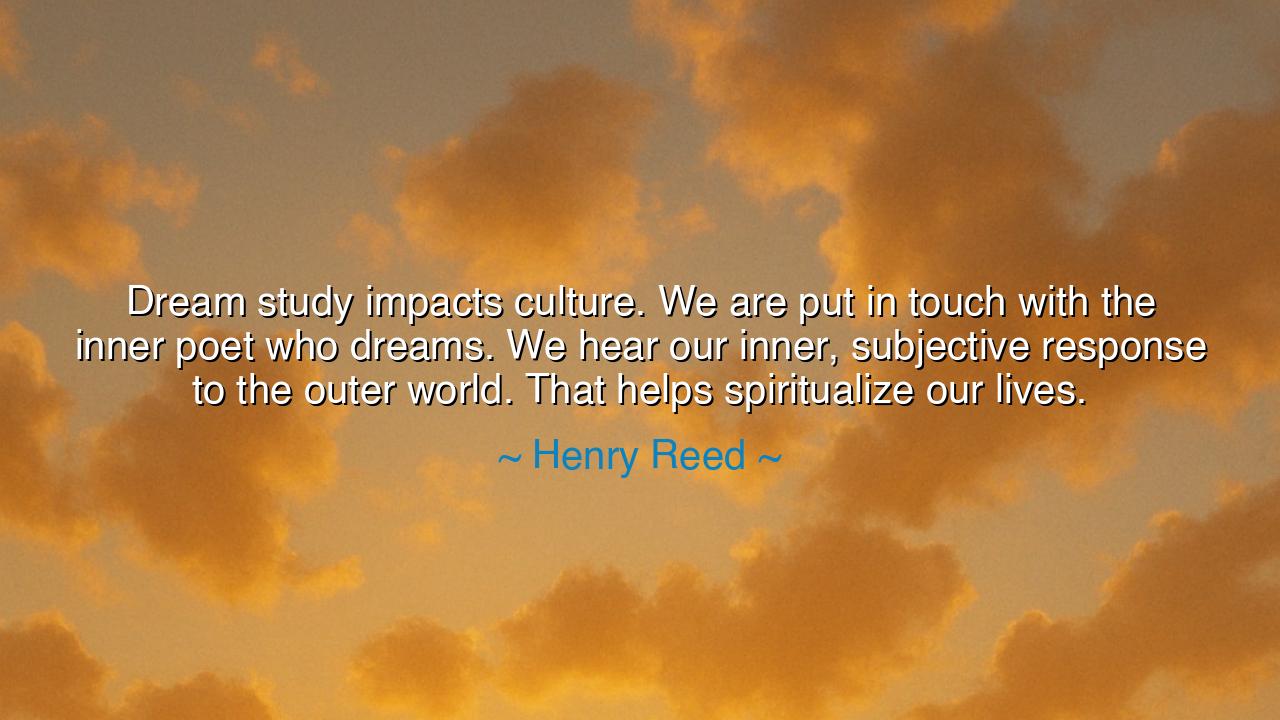
Dream study impacts culture. We are put in touch with the inner
Dream study impacts culture. We are put in touch with the inner poet who dreams. We hear our inner, subjective response to the outer world. That helps spiritualize our lives.






Listen well, children of reflection, and attend to the wisdom of Henry Reed, who observed: “Dream study impacts culture. We are put in touch with the inner poet who dreams. We hear our inner, subjective response to the outer world. That helps spiritualize our lives.” In these words lies a profound truth: that dreams are not mere illusions of slumber, but vessels through which the soul converses with the self, with society, and with the divine. They are bridges between the inner and outer realms, shaping both the spirit of the individual and the culture of the collective.
Since time immemorial, civilizations have revered dreams as sacred messengers. The Egyptians inscribed dreams upon papyrus, interpreting visions as divine guidance. The Greeks and Romans, philosophers and poets alike, sought meaning in the nocturnal visions of kings and commoners. Reed’s insight reminds us that dreams do not simply reflect private experience—they carry the potential to impact culture, influencing thought, creativity, and the moral and spiritual imagination of entire societies.
Through dreams, the inner poet speaks. Every human being possesses a wellspring of imagination and feeling that rises in the quiet hours of night, beyond conscious control. These visions, filled with symbolism, emotion, and narrative, awaken our capacity for empathy, insight, and reflection. Consider the poet Samuel Taylor Coleridge, whose famous work Kubla Khan was inspired by a dream he could only partially recall upon waking. The inner poet who dreams shaped a cultural artifact, a creation that continues to resonate centuries later, demonstrating how private vision can enter the public sphere.
Dreams also reveal our subjective response to the outer world, acting as a mirror of perception and experience. They translate the pressures, joys, fears, and wonders of waking life into symbols and narratives, offering insight into our reactions, biases, and aspirations. In this way, dreams become a tool for self-knowledge, allowing us to confront what we might not perceive consciously. Just as a sculptor sees form within stone, the dreamer perceives hidden truths within the nightly visions that arise.
Historically, dreams have guided not only artists but leaders and thinkers. Abraham Lincoln, for instance, famously dreamt of events foretelling national tragedy, shaping his approach to leadership and compassion during the Civil War. These nocturnal revelations did not exist in isolation; they informed his decisions, affecting the fate of a nation and its culture. Dream study, therefore, is not a trivial pursuit—it bridges the private and public, the inner life and societal consequence.
The act of interpreting dreams spiritualizes life, as Reed notes. By attending to our nocturnal visions, we nurture the soul, connecting the conscious mind to the mysterious depths from which imagination, creativity, and moral insight arise. In an age often dominated by material pursuit and distraction, engaging with dreams reminds us of the unseen forces that shape character, culture, and collective consciousness. The spiritual becomes tangible through the attentive eye of the dreamer.
Practical counsel emerges naturally. Keep a dream journal, reflect upon recurring symbols, and consider how these visions mirror your waking experiences. Engage with the inner poet, allowing creativity, empathy, and insight to flourish. Observe how dreams illuminate not only personal desires and fears but also societal values and cultural currents. By doing so, one transforms private vision into living wisdom, contributing both to personal growth and to the spiritual depth of the community.
Finally, remember that dreams are more than idle nocturnal wanderings. As Henry Reed instructs, they are the language of the soul, the conduit for culture, and the path to spiritual enrichment. To honor them is to honor oneself and one’s place in the larger tapestry of human experience. By listening, reflecting, and applying their lessons, the dreamer participates in a timeless dialogue, one that shapes hearts, minds, and civilizations alike.
If you wish, I can also craft a poetic, rhythmic version of this explanation for audio narration, highlighting the flow of Reed’s insight for meditative and inspirational listening. Do you want me to do that?






AAdministratorAdministrator
Welcome, honored guests. Please leave a comment, we will respond soon